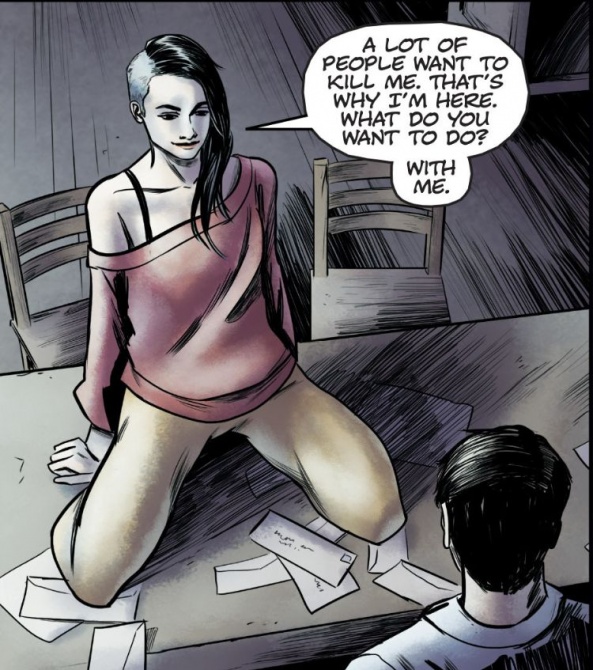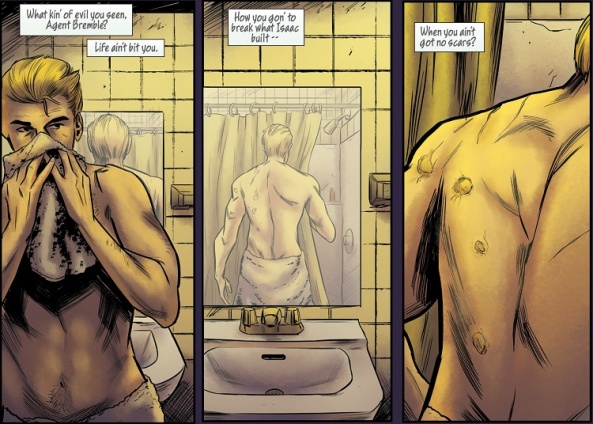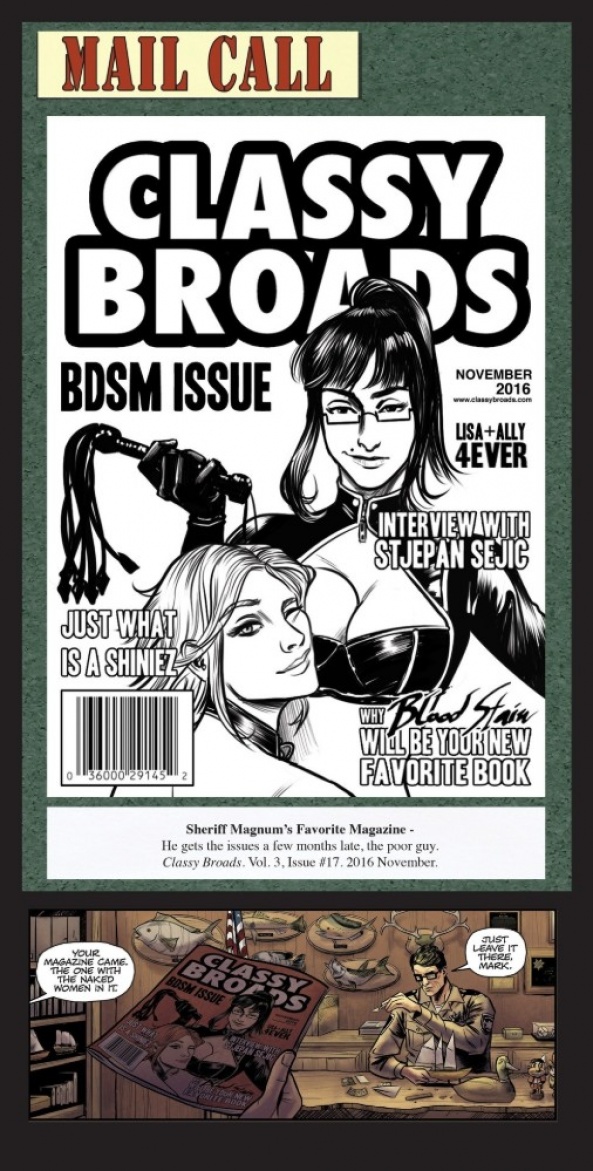Welcome to Postal Notes, a critical read through of the series “Postal.” This series of columns will be done in a mixture of essays and observations of various lengths. I will be using the seven core trade paperbacks that collect issues #1-25 and the various one shots for a total of 27 issues overall. In this column we’ll be working through the third trade, issues #9-12. The first four issues of “Postal” are on Comixology Unlimited.

Staffing Changes
Between the third and fourth trades of “Postal,” the creative team goes through several changes. In the third volume the most noticeable change is Bryan Edward Hill becoming the sole writer for the series, Matt Hawkins remained creatively informed but other than writing the “Postal: Mark” one shot doesn’t appear as directly anymore. Less noticeable is Betsy Gonia transitioning to just coloring with Ryan Candy coming on as editor. Gonia will leave the book after #12 and be replaced with colorist K. Michael Russell, who we will discuss in the next column.
These staffing changes do lead to some slight variations in how the series and characters are presented. From a writing perspective, these character don’t suddenly take 180 degree turns, but there is a difference in how Hill and Hawkins approach the cast and their overall method. When we get to the pair of epilogue issues in volume 7, their different methods will be more evident. In this batch of four issues one of the clearest surface level changes is a lack of internal monologue from Mark. That device only shows up in three sequences that functionally add more clarity to some subtle actions Goodhart is representing than to internally grapple with himself. This places further emphasis on a mixture of subtle differences in Goodhart’s character work and to some degree reader projection, in decoding the emotional state and intent of Mark. Which creates a fair amount of tension as Mark goes to some cruel places as he tries to deal with newcomer Molly Schultz.
Another noticeable change in the long run is the series overall tonality, it becomes more playful compared to the straightness of the first 8 issues. Things begin to lean into the pulpy, conspiratorial, side of things as we meet the fabled second JFK shooter in the Edenverse. This sort of extremity was baked into the series foundation, we have dream sequences and a conscious accessing of religious symbolism from the start, but there is more of a playful tone to it now. The shooter, Dallas, is introduced remarking that “purgatory is making mash in a dirty pot. Hell is when the ‘shine tastes of metal.” He studiously informs Magnum and Mark on the specific pot he wants and the fresh strawberries, since frozen fruit is for “savages.” There is a more obvious personality an eccentricity to him, a side character we don’t really see again.
Playfulness also comes through in how scenes are visually arranged allowing for a bit more irony to come through. As Mark asks Magnum for help in dealing with Molly, the town sheriff explains all the consequences of taking this actions entails, before reaffirming “god damn right I will” help him and places his hand on his shoulder. It’s the step dad equivalent of shaking Dillion’s hand in Predator. Dialectically people don’t suddenly read differently and quip all the time, but there is more room for wit to come through in their presentation. That sense of playfulness helps to both sprinkle in some light moments and underscore the darkness that is slowly encroaching around them.
How Do You Solve a Problem Like Molly?
After being teased by the mysterious character at the end of volume 2, readers are quickly introduced to Molly Schultz. She makes herself known about town by quickly committing double homicide. The “Postal” creative team have a knack for adding depth and proving people not to be the stereotype they initially appear to be, the same is true for Molly. She isn’t a Party Girl. She is a manipulative sociopath. There is a simplicity to the character that works very well in this comic and she’s one of the better written side characters in the series. And yet, I also don’t know if I really like the character, not on some moral level, but how she fits into the overall cast tapestry and how that presents a limited view of female characters.
Continued below
After having a late night chat with her, Mark remarks that she is simple “the same way a shark is simple.” In a medium where the mainstream demands efficiency and synergy, that is a brilliant description and explanation for her character. It lets you know everything you need to know about that character on the first page of issue #10. The creative teams finds some ways to if not complicate, show some of the complex actions capable within that simplicity, mainly through her manipulation and actions as a display of intense agency and visually treating the character as a femme fatale. Visually it can be a bit over done or one note, as Goodhart and Hill continually lean into the femme fatale aspect of the character as she attempts to martial her sexuality to manipulate Mark. Goodhart costumes the character in either clothing that accentuates her body or makes her into a dangerous predator such as the spiked leather jacket when she assaults Maggie. Both feel perfectly fitting modes of dress for her. On a technical level Molly Schultz is a wonderfully realized character.

Technically she is well done, it’s in the larger constellation of “Postal” that feelings of ambivalence creep in. For a series that trades in religious symbolism it isn’t hard to read this now trio of female characters within a general Madonna – Whore scheme, wherein Maggie is the Madonna and Maggie is Whore. The binary duality of that view comes through in how Maggie and Molly are treated as differing sides of the same coin. Maggie is represented as chaste, by “Postal” standards, and the object of desire for Mark. Molly, meanwhile with her rampant sexuality is the opposite but no less the object of desire for Mark, one he is just not acting upon yet.
As John Jennings has mentioned one of the fascinating aspects of comics is how they use stereotypes, that is a fixed view/representation of someone or thing, inherently due to their visual presentation and how through sequential art there is room to challenge that static representation. Which is why viewing and arguing for the above paradigm feels somewhat wrong even if it is clearly textually justified. Molly is at her core, simple like a shark, but in that simplicity is an amazing level of self-awareness and fierce level of agency as she plays with the citizenry of Eden, much to Mark and Laura’s dismay. Her will is often destructive to those around her. Maggie wants to be a better person, but also murdered someone in cold blood for rhetorically dubious reasons in the previous collection.
As the saying goes, people complain multitudes, and the ability of the creative team to develop that sense of depth is a major plus for the series. It also allows for something of a bittersweet end point for Molly in this collection, locked in a cage inside the remains of the old mine. Of all Mark’s actions there is something truly monstrous in locking her away, and the perfect picture he leaves for Maggie puts an exclamation mark on it. I feel some amount of emotion for the character, which is surprising considering how bald faced they are about her manipulative personality. One of the upsides of clearly stating that this character is inherently manipulative is you kind of hope maybe she’s turning over a new leaf and really means her promise to be “good.”
The Opposite of Close
As Molly blackmails Mark to spend time with her, the creative team, primarily through Isaac Goodhart’s layouts, do all in their power to reinforce the discord and lack of intimacy between the two. The visual cues as they go on their walks throughout the collection and primarily in in issue #12 are informed by doing the opposite of what we have seen Mark and Maggie together, further reinforcing the idea of Molly as a dark mirror for Maggie. Maggie and Mark’s talk from the previous volume (see: Postal Notes. Vol 2) while voyueristic at times, it emphasized the closeness between the two. Mark and Molly’s time together is an example of how to visually separate and create distance between two people walking and holding hands.
Continued below
As they walk around, Isaac Goodhart at times physically dislocates one or the both of them from each other, cutting Mark into a bust on the first page of issue #12 and turning both of them into talking heads on the following page. As talking heads they are arranged as if they are facing one another, having a conversation, except for their existing on separate planes and this met gaze is the visual opposite of the previous panel. When Mark and Maggie are shown playing hide and seek at the start of this collection, Goodhart overlays a panel showing Maggie behind a tree. This panel has enough visual information that ties them to the same general space, as well as not give away the answer until Mark discovers it. As talking heads Molly and Mark are backed by shades of green, matching the grass that surrounds them on the previous panel. These shades of green, however, lack the distinct visual information of Maggie’s panel, which when taken out of context furthers to emphasize their lack of union.
The lettering by Troy Peteri also reinforces the distance between the two by visually separating and otherwise obscuring a clean view of this would be couple together. Their dialog in the panel previous to their becoming talking heads is stacked high into the trees drawing the readers eye away from them and slowly bringing them down to their clasped hand and the distance between them as Mark is clearly angling away from Molly. Even in a straight ahead medium view of the two, Mark’s internal monologue is pasted over them. The same goes for the following panel, an even tighter close up of their clasped hands. In this case his monologue explains to the reader “why” he is so close, it also helps explain what is visually a jumbled mess of interwoven hands.
Another good example of this visual storytelling, which also happens to be a Mark and Molly scene is when Mark visits her by her trailer in #11. Molly is hanging out on a swing singing “Possession” by Sarah McLachlan, the entire page is encapsulates the characters femme fatale nature through the environment. The tree she is swinging on is right up against a cliff, which topographically seems slightly out of place for Eden but is good storytelling. From one vantage point, the approach, she seems safe but as you get closer things become more and more perilous. But she’s invincible and rides that fine line asking/commanding Mark to push her and make it feel like she’s flying.
This is around the time “Postal” starts to come into its own, it has developed enough of a visual language that it can now twist and complicate it to enhance the emotion behind a given scene.
I am an F, B, I, Agent!
After appearing at the end of the “FBI Dossier,” collected in the second volume, Agent Bremble begins to make his presence felt at the FBI headquarters in Wyoming and in the larger narrative as he hunts for the Brigadoon like Eden. When I had first read the series, the “Dossier” issue was something I skipped – it seemed like and mostly was a repackaging of backmatter material from the first trade paperback. This made his sudden appearance bit odd but all his wants and needs are made clear in time.
Introducing Agent Bremble gives the series something it really hasn’t had up to that point, a recurring C-plot, which more easily allows the series to cut away from moments of high tension and lulls. Over the remaining issues this is an advantage for “Postal” as it allows the series to slowly seed the long game while still primarily dealing with the struggles of the core Eden based cast in the present.
Bremble’s quest for Eden puts him on the trail of Isaac, who is absent from this batch of issues. Hunting for Isaac allows Hill to begin to reveal other aspects about the history of Eden that doesn’t rely on maneuvering characters to a space where they are ready to recollect and exposit to Mark. Bremble’s interview with Mr. Pross helps to situate Eden in a specific time and place. According to Mr. Pross, a Vietnam veteran, Eden was founded between 1969-72 which would put it at the tale end of the hippie counter culture movement in the United States. This information helps to view Eden as a fantastical outlier of that period, fitting the pulpy sensibilities and lost idealism at the root of the comic.
Continued below
Agent Bremble brings his own historical context to the series, his experience in my generations quagmires in Afghanistan and Iraq. Which gives the series a bit of a generational rhyming quality. His experiences in Afghanistan have given him an intense since of self-loathing and appreciation of the Law. Mr. Pross sneers at Bremble for being to clean cut, judging by his outward appearance, to take down Isaac or Eden. Appearances deceive in “Postal” which we see again when Bremble cleans up and reveals his scars to the reader. This moment of revelation is an inverse of the motif, normally we are shown people putting on the mask and becoming someone here it is all stripped with a shower, shave, and six panel gird.
Universal Bleed

A little easter egg appears towards the end of the issue. Ally and Lisa from “Sunstone” and the Sejic-verse appear on an adult magazine meant for Sheriff Magnum. It’s asking the real important questions: What is a Shniez? (Yes, I know it’s supposed to be a portmanteau of ‘Shiny + Latex’ but I don’t see it.) The Sejic-verse, is currently constituted of reprints of the webcomics by Stjepan and Linda Sejic,“Sunstone” and “Blood Stain” respectively.(Coverage of “Blood Stain” can be found in Webcomics Weekly) and OGN series “Swing” by Matt Hawkins and Jenni Cheung. It is pretty much the tonal opposite of the Edenverse. Where the Edenverse is steeped in pervasive criminality with a Michael Crichton streak, the Sejic-verse are slice of life comedies and erotica as people try to figure out how to make the relationships in their life function.






